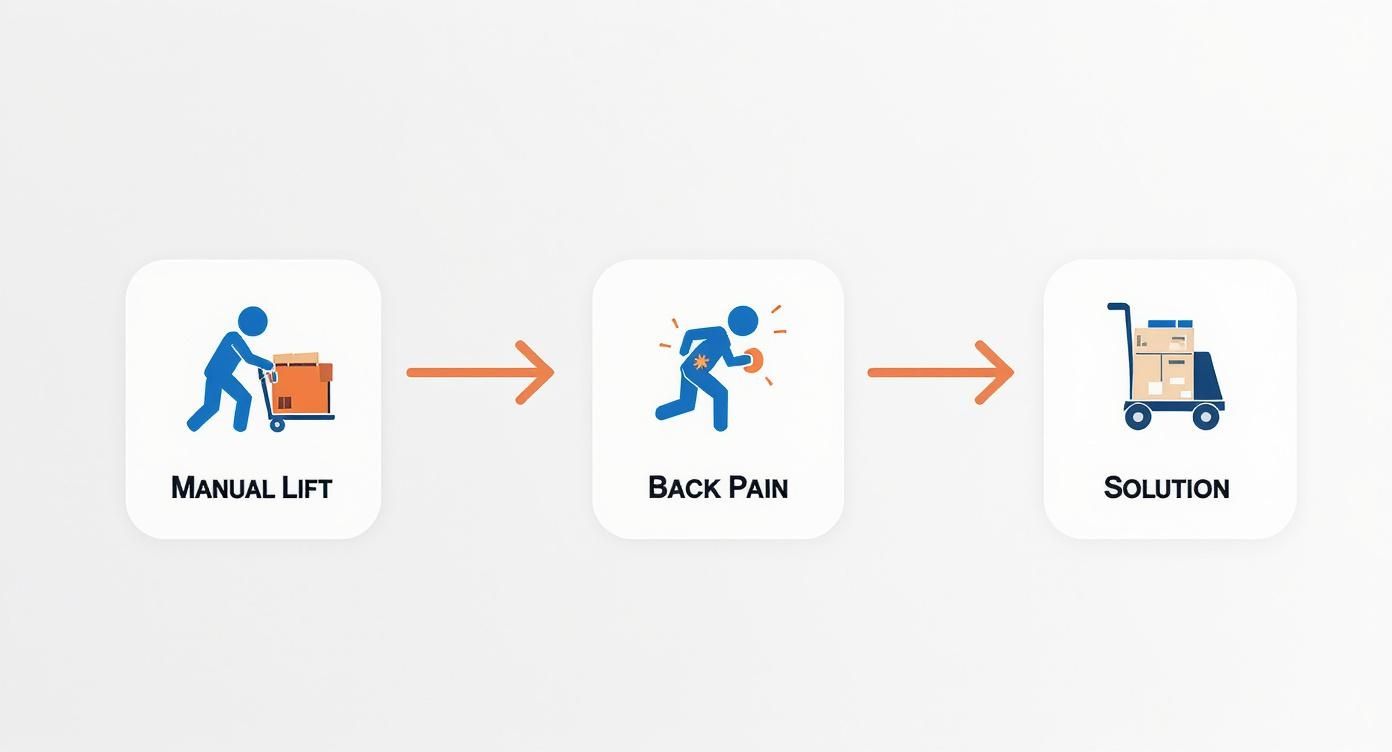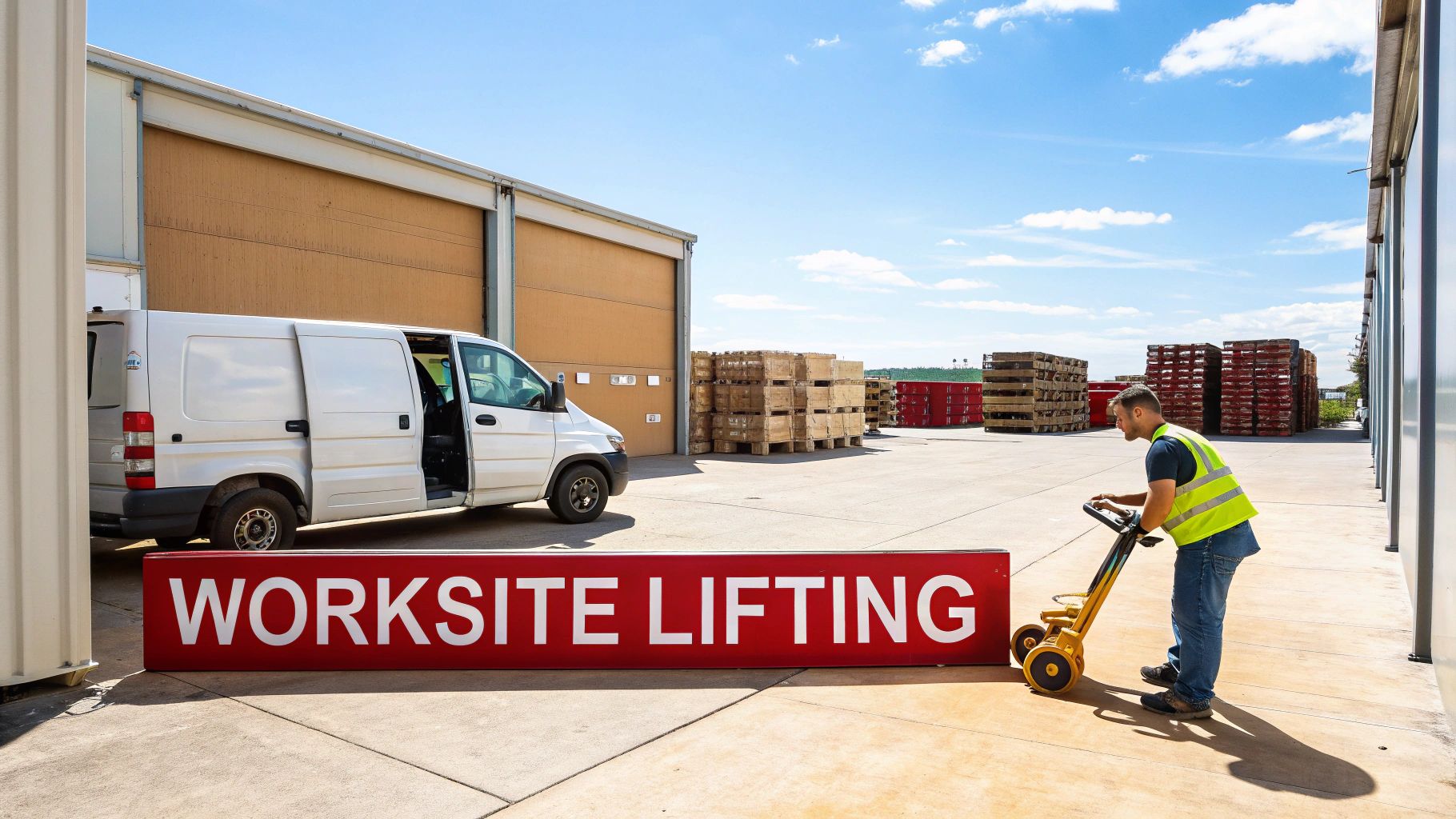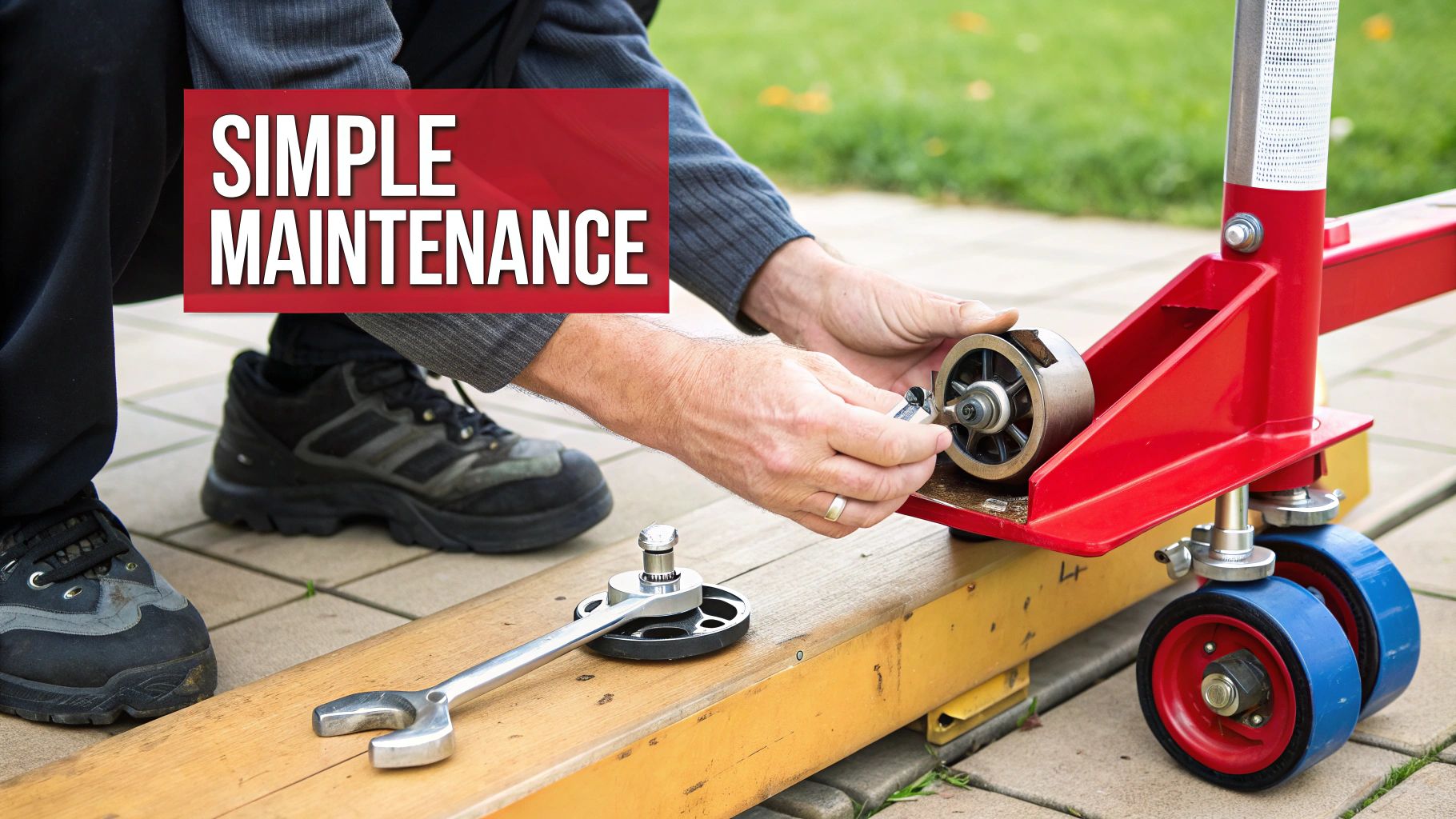Ever found yourself staring down a heavy engine block or a stack of boxes that just won't move themselves? This is where a hydraulic lifting trolley becomes the best tool in your workshop. Think of it as a mobile workbench and a car jack all rolled into one, built to solve the daily headache of lifting and positioning heavy gear in workshops, warehouses, and factories across Australia.
A hydraulic lifting trolley is much more than just another piece of equipment; it's a game-changer for workshop safety and efficiency. Its main job is to put an end to the risky manual handling that so often leads to back injuries and costly downtime. By taking the strain out of the equation, it lets one person safely tackle jobs that used to need two or three sets of hands.
This simple but tough machine completely changes how work gets done. Instead of risking a pulled muscle heaving a heavy component from the floor to a workbench, your team can slide it onto the trolley, pump it up to the perfect height, and position it with pinpoint accuracy. This doesn't just protect your people—it seriously speeds up the entire operation.
The benefits of adding a hydraulic lifting trolley to your workflow are immediate and easy to see.
The demand for this kind of gear is undeniable. The Australian hydraulic equipment market, which includes these trolleys, was valued at $1.27 billion AUD in 2024 and is set to keep growing. It’s clear that businesses nationwide are shifting towards smarter, safer ways to handle materials.
Here at Super Rack, we see this trend every day. Our customers come to us for trolleys that are built tough and priced right. With our fast, nationwide delivery and real-world advice from experts, we make it easy to invest in your workshop's safety and productivity.
Ever wondered how a few easy pumps on a foot pedal can lift hundreds of kilograms without you breaking a sweat? It’s not magic, and there’s no complex motor whirring away inside. The secret is a brilliant piece of engineering called a hydraulic system, and it turns a small effort into immense lifting force using simple, reliable physics.
At its heart, a hydraulic lifting trolley works by putting fluid under pressure. Picture a mechanic needing to position a heavy gearbox perfectly onto an engine block. Instead of straining their back, they just pump a foot pedal. Each push forces hydraulic fluid from a storage tank (the reservoir) into a lifting cylinder, which smoothly and steadily raises the trolley’s platform. Simple as that.
This whole process is a real-world application of Pascal's principle. In simple terms, this principle says that pressure applied to a fluid in a closed container is distributed equally everywhere. The foot pump applies force over a small area, which gets multiplied into a much bigger force inside the main lifting cylinder. It’s the closest thing to having a superpower that lets you lift incredible weights with minimal effort.
The real genius of a hydraulic lifting trolley is how three key parts work together in perfect harmony. Once you know their roles, you’ll appreciate just how reliable this design is.
The infographic below shows the clear shift from risky manual lifting to a safe, efficient process using a trolley.

This simple flow highlights how introducing a hydraulic trolley directly tackles workplace hazards by replacing dangerous physical strain with smart mechanical efficiency.
At Super Rack, we believe in providing equipment that is not only powerful but also intuitive and safe. Our hydraulic lifting trolleys are designed with superior quality seals and durable cylinders to ensure leak-free performance and a long service life, giving you a reliable tool you can count on day in and day out.
Picking the right hydraulic lifting trolley isn’t about just grabbing one off the shelf. It's about matching its capabilities directly to the jobs you need it to do, day in and day out. Not all trolleys are built the same, and getting to know the key features is the only way to make sure you’re investing in a tool that actually helps your business, not hinders it.
Think of it like this: the features are the language the trolley uses to tell you what it’s good at. Once you understand that language, you can pick a model that’s a perfect fit for your workshop, warehouse, or factory floor. This stops you from overpaying for capacity you’ll never use or, even worse, buying a trolley that can’t handle your most common tasks.
The two most critical numbers you need to look at are the load capacity and the lift height.
Load capacity is simple: it’s the maximum weight the trolley can safely handle, usually measured in kilograms (kg). While it’s tempting to go for the biggest number you can find, it’s far more practical to think about your typical loads. A mechanic lifting gearboxes might only need a 150kg trolley, whereas a warehouse shifting engine parts will need something closer to 500kg or more. Always pick a capacity that comfortably exceeds your heaviest regular item to give yourself a solid safety margin.
Lift height tells you how high the platform can go. Are you lifting items to a standard workbench, or do you need to get them into the back of a delivery van? Take a moment to measure the highest point you’ll need to reach and choose a trolley that meets or beats that measurement. It's a simple check that saves a lot of frustration down the line.
The wheels might seem like a small detail, but they make a massive difference to how the trolley handles. The right set of wheels makes moving a heavy load feel almost effortless, but the wrong ones can turn every job into a back-breaking struggle.
Here’s what to look for:
Investing in quality material handling equipment is a significant decision for any Australian business. This sector is a core part of the national economy; cranes and lifting equipment, including the hydraulic lifting trolley, accounted for 36.84% of the $3.8 billion AUD material handling market in 2023. You can find out more about these industry trends and market forecasts at Grand View Research.
Any decent hydraulic lifting trolley should have safety built into its design. One of the most important components is the overload protection valve. This is a clever safety mechanism that stops you from even trying to lift something heavier than the trolley's rated capacity. It protects the hydraulic system from damage and, more importantly, prevents dangerous failures.
Secure wheel locks are another non-negotiable feature. They ensure the trolley stays put exactly when you need it to, providing a stable and safe base to work from.
At Super Rack, we know that reliability and safety are everything. That’s why our trolleys are built with top-quality components, from the hydraulic pump right down to the wheels. We provide expert advice to help you choose the right features for your job, ensuring you get a competitively priced tool that’s delivered fast, anywhere in Australia. For operations needing different transport solutions, consider exploring options like our versatile roll cage trolleys.
Let's move from theory to what happens on the ground in busy Australian workplaces. A hydraulic lifting trolley is much more than a workshop accessory; it's a genuine problem-solver for those everyday jobs that cost businesses time and money while putting workers at risk. Seeing them in action really shows their true value.
Think about a bustling logistics depot in Western Sydney during the morning rush. A worker is using a 500kg hydraulic lifting trolley to load heavy parcels into courier vans. The trolley’s platform raises each item perfectly level with the van's floor, so the worker can slide it straight in—no dangerous lifting, no awkward bending. This simple move is repeated dozens of times, shaving minutes off each load and massively cutting down the risk of worker strain.

Now, picture a mechanic's workshop in Melbourne. A heavy transmission has to be lined up perfectly with an engine block. This used to be a tricky, two-person job with a lot of guesswork and muscle.
Today, a single mechanic uses a hydraulic lift trolley to raise the transmission, making tiny, controlled adjustments to get the alignment spot on. The trolley doesn't just hold the weight securely; it acts as a stable work platform, turning a high-risk task into a safe, one-person operation.
Across Australian industries, especially in transport and logistics, these trolleys are vital for tasks like facilitating thorough vehicle inspections, helping workshops meet strict safety standards.
Over in a large retail warehouse in Brisbane, staff are restocking bulky items on high shelves. Instead of climbing an unstable ladder while wrestling a heavy box, an employee wheels a loaded trolley into the aisle.
With a few pumps of the foot pedal, the platform rises right to shelf height. This makes restocking safe and efficient, keeping inventory moving and the shop floor supplied without putting staff in danger of falls or manual handling injuries.
The stories from these different industries all point to one thing: a hydraulic lifting trolley solves problems. It directly tackles the common challenges of lifting, positioning, and moving heavy items safely and efficiently.
At Super Rack, we stock high-quality, competitively priced trolleys built for these exact situations. With fast, nationwide delivery and expert advice ready to go, we'll help you find the perfect solution to boost productivity and safety in your operation from day one.
Ready to buy a hydraulic lifting trolley but feeling a bit lost in all the options? Don’t worry, picking the right one is easier than you think. By answering a few simple questions about what you do day-to-day, you can quickly find the perfect model that will be a reliable workhorse for years.
This checklist is designed to cut through the noise and help you focus on what actually matters. It’s all about avoiding the classic mistakes: either spending too much on an oversized trolley you don’t need, or worse, getting one that’s not up to the job and gives out when you need it most. Let's get started.
Before you start looking, take a minute to think about these three things:
Choosing a brand-new trolley from a trusted supplier like Super Rack is a smart investment. It guarantees you receive a reliable, high-quality unit backed by a full warranty and expert support, giving you complete peace of mind.
The material handling market in Australia is growing fast, expected to hit $14.2 billion AUD by 2033. This tells us that more and more businesses are investing in safer and more efficient gear like hydraulic lifting trolleys. While it's a niche market, this trend points to a healthy demand for quality lifting equipment. If you're keen to dig deeper, you can find research on the hydraulic lifting trolley market online.
Thinking through these practical details is what ensures you get real value. For instance, a trolley that lifts to the exact height of your main work and storage bench creates a smooth, ergonomic workflow. It saves time and, more importantly, reduces the physical strain on your crew. It’s these small details that make a huge difference in daily operations.
By taking the time to think about your specific needs, you can confidently choose a hydraulic lifting trolley that doesn’t just do the job, but actually makes your workplace safer and more productive.
A quality hydraulic lifting trolley is built to handle the daily grind, but a little bit of simple upkeep will make sure it operates safely and efficiently for its entire lifespan. The good news is you don't need to be a mechanic to keep your trolley in great shape.
Taking just a few minutes for these routine checks really goes a long way. It helps prevent unexpected downtime, keeps your team safe, and ensures your equipment remains a reliable workhorse for years. Think of it as a quick tune-up that protects your investment.

Preventative maintenance is always smarter—and cheaper—than dealing with a breakdown. By regularly checking a few key areas, you can catch small issues before they snowball into big problems.
Here’s a simple checklist to follow:
At Super Rack, our commitment to value goes beyond the initial sale. We provide superior quality, durable equipment and offer expert advice to help you maintain it. A well-cared-for hydraulic lifting trolley from a trusted supplier is an investment in long-term safety and productivity.
To help you feel confident you're making the right choice, we’ve put together straight answers to the questions we hear most about using a hydraulic lifting trolley in Australian workplaces. These should clear up any last-minute questions you might have.
Think of a standard trolley as a workhorse for moving things horizontally—from A to B on the same level. A hydraulic lifting trolley does that too, but its real magic is lifting goods vertically to a precise, controlled height.
This dual-action makes it the perfect tool for loading a ute, positioning a heavy engine block on a workbench, or safely stocking shelves. It cuts out the manual lifting and awkward bending that are behind so many workplace injuries.
You bet. When they're used correctly, safety is their number one design feature. Any quality model from a reputable supplier will include an overload protection valve, which stops anyone from even trying to lift more than its rated capacity.
They also come with lockable wheels to make sure the trolley stays put while you're loading or unloading. Stick to the manufacturer’s guidelines and Australian safe work practices, and you'll have a safe, reliable piece of kit.
Proper user training is the final piece of the safety puzzle. Making sure your team understands load limits, safe travel paths, and correct lifting procedures is the best way to protect both your staff and your equipment.
While they are incredibly user-friendly, we always suggest some basic operational training for anyone who's going to use the equipment. This just makes sure everyone on the team gets how the load limits work, the right way to use the foot pump and release valve, and how to steer a loaded trolley safely.
A quick rundown with your team is a small investment that pays huge dividends in safe, efficient, and problem-free use for years.
Ready to boost safety and efficiency in your workplace? Check out the superior quality, reliable range of material handling solutions at Super Rack. Our expert team is here to help you find the perfect gear for your needs with fast, nationwide delivery and competitive pricing. Visit us at https://www.superrack.com.au to learn more.
4000 to 4182
4186 to 4207
4300 to 4305
3000 To 3096
3098 To 3112
3114 To 3138
3140 To 3157
3161 To 3198
3200 To 3207
Let's connect